Sensor Sweep: Edmond Hamilton, Arthur Gilchrist Brodeur, Sentinel Module
Monday , 21, July 2025 Sensor Sweep Leave a commentMagazines (Twilight Zone Vortex): –Klein provides biographical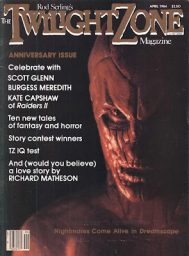 information on the winners of the magazine’s third annual short story contest, and describes the characteristics which made their work stand out from the other submissions. Klein next highlights the Twilight Zone quiz created by high school senior Gary Frisch, and the interview with actor Burgess Meredith conducted by James H. Burns.
information on the winners of the magazine’s third annual short story contest, and describes the characteristics which made their work stand out from the other submissions. Klein next highlights the Twilight Zone quiz created by high school senior Gary Frisch, and the interview with actor Burgess Meredith conducted by James H. Burns.
Tolkien (The Spectator): In a recent diary for The Spectator, the editor noted that many of the world’s leading tech companies have names inspired by The Lord of the Rings: Peter Thiel’s Palantir and Mithril; Palmer Luckey’s Anduril. ‘J.R.R. Tolkien has a curious hold on the minds of Silicon Valley’s Trump supporters,’ he wrote.
Fiction (Paperback Warrior): Way back in 2019 I read a novel by British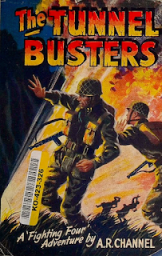 writer Arthur Catherall titled The Strange Intruder. I enjoyed the book immensely and have kept a watchful eye out for the author’s work ever since. Unfortunately, despite his accomplishments as a successful young-adult writer, he has gone out of print and out of the public’s eye. Thankfully, the power of the internet has produced some scans of a few of his out-of-print books including three of his exciting Fighting Four novels.
writer Arthur Catherall titled The Strange Intruder. I enjoyed the book immensely and have kept a watchful eye out for the author’s work ever since. Unfortunately, despite his accomplishments as a successful young-adult writer, he has gone out of print and out of the public’s eye. Thankfully, the power of the internet has produced some scans of a few of his out-of-print books including three of his exciting Fighting Four novels.
 Art (John Coulthart): This illustration by Gustave Doré (with engraving work by Louis Sargent) is a beautiful example of how to fill a scene with detail and texture without losing a sense of depth or control of the light and shade. Piranesi’s etchings, especially his views of Roman ruins, are often as skilfully rendered, resisting the tendency of concentrated shading to turn into a depthless field of grey.
Art (John Coulthart): This illustration by Gustave Doré (with engraving work by Louis Sargent) is a beautiful example of how to fill a scene with detail and texture without losing a sense of depth or control of the light and shade. Piranesi’s etchings, especially his views of Roman ruins, are often as skilfully rendered, resisting the tendency of concentrated shading to turn into a depthless field of grey.
Cinema (Modern Age Journal): Superman occupies a decisive place in American popular culture, for better or for worse. The character, who debuted in 1938, is usually credited as the first superhero, the beginning of a genre that now dominates not only comic books but Hollywood as well. In terms of mass culture, we’re living in the world Superman made.
Fiction (Silver Key): Written storytelling has a unique and curious aspect. If a story has a great enough impact, re-reading it can take you back to a distinct place and time in your life, even decades later. It’s a power that I don’t think movies quite possess, perhaps because of the images you form in your brain while reading.
Robert E. Howard (Robert E. Howard Foundation): The Biographies of Robert E. Howard is a discussion of all of the major biographies of Robert E. Howard, with three of his modern biographers, Rusty Burke, Mark Finn, and Will Oliver. Part 1 looks at the autobiographical writings by Howard up to the 1986 memoir by Novalyne Price Ellis, One Who Walked Alone.
Tolkien (Notion Club Papers): At the beginning of The Silmarillion (1977) there is the creation story Ainulindale – which describes, in musical terms, how the universe is created; starting from Eru, The One, prime creator God.
Robert E. Howard ( Pulp Super Fan): Most hopefully are aware of Robert E. Howard (1906-36), a pulp writer who is credited as the “father of sword & sorcery,” creating such well known characters as Conan the Barbarian, Solomon Kane, Kull, and more. A group of fans came together to establish the Robert E. Howard Foundation in 2006.
Pulp (Pulp Super Fan): An interesting pulp author I want to focus on is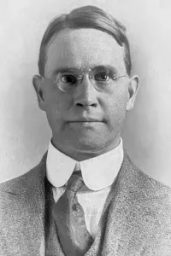 Arthur Gilchrist Brodeur (1888-1971), who was a scholar of early English, German, and Old Norse literature at the University of California, Berkeley. Academically, he is probably best known for his work on Beowulf and for his translation of Snorri Sturluson‘s Prose Edda, which is still in print. But he was also a pulp author, writing several historical fiction works that appeared in Adventure and Argosy All-Story, several co-written with his friend Farnham Bishop (1886-1930).
Arthur Gilchrist Brodeur (1888-1971), who was a scholar of early English, German, and Old Norse literature at the University of California, Berkeley. Academically, he is probably best known for his work on Beowulf and for his translation of Snorri Sturluson‘s Prose Edda, which is still in print. But he was also a pulp author, writing several historical fiction works that appeared in Adventure and Argosy All-Story, several co-written with his friend Farnham Bishop (1886-1930).
Fantasy (Dark Worlds Quarterly): In the January 1985 issue of Isaac Asimov’s Science Fiction Magazine, Ike wrote an editorial all about Sword & Sorcery. No surprise, it was called “Sword and Sorcery”. As an SF snob, which Ike was admittedly in such books as Before the Golden Age (1974), you know Asimov is not going to say things like “Wow! Sword & Sorcery is better than SF!” His attitude towards Weird Tales is typical of the SF snobs of the 1930s dismissing the publications as “creepy-crawlies”.
Pulp (The Obelisk): Recently, a friend of the Bizarchives asked me to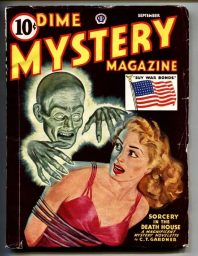 compile a list of the most interesting and exciting sub-genres of pulp fiction. Since I am not one to disappoint, I would like to herein present a brief and concise look at the five pulp sub-genres that I find the most intriguing. You may agree or disagree, but you cannot say that these odd pulp styles are boring.
compile a list of the most interesting and exciting sub-genres of pulp fiction. Since I am not one to disappoint, I would like to herein present a brief and concise look at the five pulp sub-genres that I find the most intriguing. You may agree or disagree, but you cannot say that these odd pulp styles are boring.
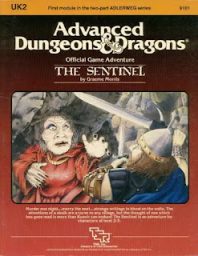 D&D (Grognardia): Published in 1983, module UK2, The Sentinel, is the first part of a two-module series written by Graeme Morris for Advanced Dungeons & Dragons. Along with its sequel, which I’ll discuss in this space next week, it stands out as a distinctive offering in TSR’s early ’80s catalog.
D&D (Grognardia): Published in 1983, module UK2, The Sentinel, is the first part of a two-module series written by Graeme Morris for Advanced Dungeons & Dragons. Along with its sequel, which I’ll discuss in this space next week, it stands out as a distinctive offering in TSR’s early ’80s catalog.
Writing (DMR Books): Atmosphere should be distinguished from style. There is a fine line between the two but they are different. Prose style is how a story sounds to one’s inner ear. Atmosphere is how the story makes you feel. You could be good at atmosphere but not a perfect stylist.
Fantasy (Dark Worlds Quarterly): Lin Carter always brought a little Tolkien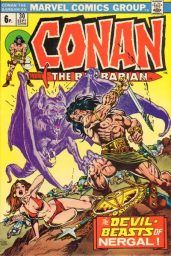 to his Conan pastiches. Case in point is the shadow-bat from “The Hand of Nergal” by Robert E. Howard and Lin Carter that appeared in Conan (1967). These critters have more than a little Ringwraith in them. Conan, a mercenary, is riding in the army of the King of Turan about to engage the forces of an unruly satrap, Munthassam Khan. Over the battle field appears:
to his Conan pastiches. Case in point is the shadow-bat from “The Hand of Nergal” by Robert E. Howard and Lin Carter that appeared in Conan (1967). These critters have more than a little Ringwraith in them. Conan, a mercenary, is riding in the army of the King of Turan about to engage the forces of an unruly satrap, Munthassam Khan. Over the battle field appears:
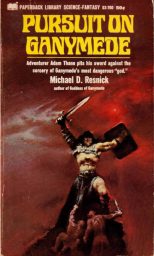 Fiction (Ken Lizzi): It was from that rack that I picked up Michael D. Resnick‘s Pursuit on Ganymede.
Fiction (Ken Lizzi): It was from that rack that I picked up Michael D. Resnick‘s Pursuit on Ganymede.
I soon discovered that this was book two, a sequel to The Goddess of Ganymede (which I may, or may not, get a copy of in the future.) Pursuit, it becomes immediately apparent, is an homage to Edgar Rice Burroughs’ John Carter of Mars books, complete with the opening chapter explaining that the following narrative is being told to another writer who is providing it for publication to us, the readers.
Writing (Pulp Archivist): This article first appeared in the pages of SFWA Bulletin 151, Fall, 2001. Since this got disappeared in part because of SFWA politics and, in greater part, the vandalism of Mike Resnick’s website by whoever turned his site into a failed science fiction casino link farm, I am posting it here as a bit of a personal bookmark. No rights claimed, and will remove on request of the parties and estates involved.
Science Fiction (Fantasy Literature): In Edmond Hamilton’s 1967 novel The Weapon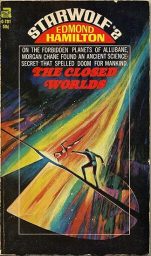 From Beyond, Book #1 of his so-called STARWOLF TRILOGY, the reader had been introduced to Morgan Chane, an orphaned Earthling who had been brought up and raised by the piratical Starwolves of the planet Varna. In that first installment, Chane had been forced to flee from the vengeful Varnans after having killed one of them in self-defense, and had gone on to work with a group of mercenaries, the Mercs, on one of their exciting missions.
From Beyond, Book #1 of his so-called STARWOLF TRILOGY, the reader had been introduced to Morgan Chane, an orphaned Earthling who had been brought up and raised by the piratical Starwolves of the planet Varna. In that first installment, Chane had been forced to flee from the vengeful Varnans after having killed one of them in self-defense, and had gone on to work with a group of mercenaries, the Mercs, on one of their exciting missions.
Science Fiction (Lotus Eaters): H.G. Wells Had a Mind Like No Other
History (Frontier Partisans): Christian Parkinson at Redcoat History has given us a very fine video on one of the many sharp conflicts in one of the most dangerous frontier zones in the world: the Waziristan Campaign of 1936-37. This was a significant episode in a periodic series of campaigns — mostly punitive expeditions, including campaigns in the 1890s and 1919-21 — that tried to keep a lid on raiding by Pathan tribesmen in the Northwest Frontier of India.
Weird Tales (Tellers of Weird Tales): The first story by Donald Edward Keyhoe in Weird Tales was “The Grim Passenger,” published in April 1925, one hundred years before I began writing this series. My move and other events have intervened. That one-hundred year anniversary isn’t so timely now. But I’ll complete this series today.
History (History Debunked): In recent decades, something very odd has happened to discussions and writing about slavery and the trade in slaves. From being considered as a general practice, something seen across the entire world throughout the whole of recorded history, as was once the case, the phrase ‘slave trade’ is now almost invariably preceded by a definite article; as in the slave trade.
Genre (Walker’s Library): Egregores change this. As I said last week: “a non-physical entity or thoughtform that arises from the collective thoughts and emotions of a distinct group of individuals. In this case, “Fantasy” publishers, editors, and cult-like readers- the counter-party to the “Science Fiction” egregore.”
History (Spyders of Burslem): After more than a century of debate, definitive scientific proof on links between Cornwall and the ancient Mediterranean. “How Britain’s long-distance tin trade transformed the Bronze Age”…
“Published in the journal Antiquity, the results provide the first concrete evidence that Cornwall and Devon were major suppliers of tin for bronze production in the ancient world.
Please give us your valuable comment